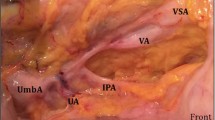Abstract
PURPOSE: Bilateral ligation of the internal iliac arteries has been reported to be a safe procedure in pelvic surgery because there are five collateral pathways. Some of the five pathways are surgically interrupted after resection of the rectum and two cases in which necrosis developed in the perineum were reported. The aim of the study was to assess the degree of safety and blood flow reducing efficacy of internal iliac artery ligation in rectal cancer surgery. METHODS: The subjects were 23 patients with advanced rectal cancer. Tissue blood flow on the surface of the bladder was measured using a laser Doppler flow meter when unilateral or bilateral internal iliac artery were clamped at a central site or at a peripheral site. RESULTS: Tissue blood flow of the bladder before clamping the internal iliac artery was 6 to 74 ml/min/100 g. Blood flow in the right half of the bladder decreased significantly when the right and both internal iliac arteries were clamped (both,P<0.01), but it did not decrease significantly when only the left internal iliac artery was clamped. The results were the same whether the central site or peripheral site was clamped. When the central site was clamped, there was no difference between the decrease in blood flow in the right half of the bladder whether the right internal iliac artery was clamped or both internal iliac arteries were clamped. By contrast, when the peripheral site was clamped, the decrease in blood flow in the right half of the bladder was much greater when both internal iliac arteries were clamped than when the right internal iliac artery alone was clamped (P<0.01). The results in the left half were the same as in the right half. Blood flow became 33 to 110 (mean, 73; median, 75) percent of the value before clamping when both internal iliac arteries were clamped at the central site, and 18 to 114 (mean, 52; median, 47) percent when both internal iliac arteries were clamped at the peripheral site. No changes in the color of the bladder or other pelvic organs were observed while the internal iliac arteries were clamped. CONCLUSION: Our study suggests that bilateral internal iliac artery ligation causes a temporary decrease in blood flow to the pelvic organs, but the reduction is not great enough to induce necrosis histologically. We recommend the ligation of the internal iliac arteries at the point below the takeoff of the superior gluteal artery to gain a considerable blood flow reducing effect on the pelvic organs.
Similar content being viewed by others
References
Seavers R, Lynch J, Ballard R, Jernigan S, Johnson J. Hypogastric artery ligation for uncontrollable hemorrhage in acute pelvic trauma. Surgery 1964;55:516–9.
Salzberg AM, Fuller WA, Hoge RH. The surgical management of profuse hemorrhage from uterine carcinoma. Surg Gynecol Obstet 1953;97:773–5.
Reich WJ, Nechtow MJ. Ligation of the internal iliac (hypogastric) arteries: a life-saving procedure for uncontrollable gynecologic and obstetric hemorrhage. J Int Coll Surg 1961;36:157–68.
Leventhal ML, Lash AF, Grossman A. Hemorrhage from carcinoma of the cervix. Surg Gynecol Obstet 1938;67:102–4.
Swinton NW, Moszkowski E, Snow JC. Cancer of the colon and rectum, a statistical study of 608 patients. Surg Clin North Am 1959;39:745–52.
Engel GC, Singmaster L. Ligation of internal iliac arteries to facilitate abdominoperineal resection for malignancy of the rectum. Surgery 1962;52:867–70.
Skinner DG. Technique of radical cystectomy. Urol Clin North Am 1981;8:353–66.
Siegel P, Mengert WF. Internal iliac artery ligation in obstetrics and gynecology. JAMA 1961;178:1059–62.
Kelly HA. Ligation of both internal iliac arteries for hemorrhage in hysterectomy for carcinoma uteri. Bull Johns Hopkins Hosp 1894;5:53–4.
Tajes RV. Ligation of the hypogastric arteries and its complications in resection of cancer of the rectum. Am J Gastroenterol 1956;26:612–8.
Andriole GL, Sugarbaker PH. Perineal and bladder necrosis following bilateral internal iliac artery ligation. Report of a case. Dis Colon Rectum 1985;28:183–4.
Shepherd Ap, Riedel GL. Continuous measurement of intestinal mucosal blood flow by laser-Doppler velocimetry. Am J Physiol 1982;242:G668–72.
Shafiroff BGP, Grillo EB, Baron H. Bilateral ligation of the hypogastric arteries. Am J Surg 1959;98:34–40.
Lipshutz B. A composite study of the hypogastric artery and its branches. Ann Surg 1918;67:584–608.
Author information
Authors and Affiliations
About this article
Cite this article
Sadahiro, S., Ishida, H., Suzuki, T. et al. Vesicular blood flow after ligation of the internal iliac arteries in low anterior resection or abdominoperineal resection. Dis Colon Rectum 42, 1475–1479 (1999). https://doi.org/10.1007/BF02235051
Issue Date:
DOI: https://doi.org/10.1007/BF02235051




